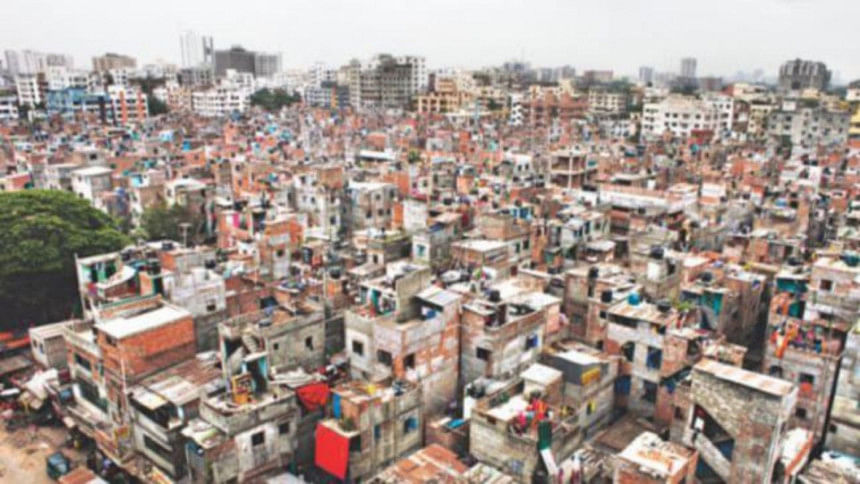Is rapid urbanisation good or bad for Bangladesh?

In the last few weeks, Dhaka has hosted a number of international workshops and meetings on issues to do with migration and also on urbanisation. One of the outcomes of these series of meetings is that the two issues are very much intertwined in the context of Bangladesh where rural-to-urban migration, primarily to Dhaka, is the major issue.
In this column, I will focus on the issue of Bangladesh's rapid urbanisation based on discussions at the three-day conference on Urban Resilience held in Dhaka last week and answer a series of questions which seem to be the most relevant in the current context.
Is rapid urbanisation good or bad?
There seems to be quite a difference of opinion on whether we should encourage or discourage rapid urbanisation in Bangladesh. In my view, it does not matter what we think, it is in fact a reality that cannot be prevented but needs to be managed. Failure to manage it will mean that it becomes a big problem, but if we do manage it then it need not be one.
The problem with rapid urbanisation based on rural-to-urban migration in Bangladesh is not that it is happening, but that almost all of it is happening in Dhaka. Hence, the solution to managing this urbanisation is to invest in other cities and towns around the country to attract the migrants there instead of Dhaka. This will mean investment in jobs, education, healthcare, etc., in secondary towns of Bangladesh.
Are slum-dwellers welcome or not?
Within our major cities, especially Dhaka, we have an ambivalent attitude to slums and slum-dwellers with some of us seeing them as a major problem to be solved by removing them while others see them worth investing in.
On this issue my view is that every person living in a city, regardless of where, is a citizen of the city and deserves to be treated equally as any other citizen. Hence, slum-dwellers deserve to be treated as citizens and be provided with services such as electricity, water, sanitation, healthcare, etc. While I accept this is not going to be easy, nevertheless, it should be done as a matter of principle.
Is infrastructure more important than people?
At the moment, the investments leading to rapid urbanisation in Dhaka, and a few other cities and towns, are in infrastructure development such as housing by the private sector and roads and embankments by the public sector. Despite the preparation and adoption of master plans for many cities and towns these infrastructure investments tend to take place in an unplanned manner (often in violation of the master plan or other legislation). While it will not be easy to reverse this trend, we need to think about shifting the emphasis from infrastructure to people, with a bias in favour of the poorest and most vulnerable people. This will require the involvement and active participation of many different citizen-stakeholders in both planning as well as implementation of plans for all our cities and towns.
What is the role of the private sector?
The private sector, particularly the real estate sector, is a major factor in the process of rapid urbanisation, especially in Dhaka. Other sectors include the transport and commercial sectors at the large enterprise level and a very large informal sector of small vendors, rickshaw pullers, etc.
These actors making their own individual decisions have an impact at the aggregate level on the quality of life in the cities. The problem arises if we allow individual decisions to prevail over the collective good, which is the responsibility of the government. The rampant building of private structures in wetlands in Dhaka which are protected by law is a good example of the rich flouting the law with impunity. Bangladesh does not need many new policies and laws but does need to implement the existing laws more effectively.
Are women safe in cities?
One of the issues that have come to greater attention of late is the focus on female citizens of our towns and cities where the lack of safety, particularly for young girls, has become a real and growing problem. While there are many reasons for the lack of female empowerment in general, the need for women to feel safe while they move around and even when they are at home is a high priority. This needs to be achieved both through the effective enforcement of laws by concerned authorities, and even more importantly through civic education of young boys to improve their behaviour.
How will our urbanisation deal with climate change?
Finally, let me take on the issue of climate change linked to migration and urbanisation, where the potential adverse impacts of climate change will exacerbate the vulnerabilities of the cities and towns to floods, cyclones in the coastal areas, etc. Particularly in Dhaka city, the main problem is drainage congestion from heavy rainfall, which is already a major periodic problem for millions of citizens. These issues will need to be taken into account in all future investments in urban development all over the country.
The problem of urbanisation and that of climate change tend to be cross-cutting as they affect almost every other aspect of development and people's lives. Hence, mainstreaming both urbanisation and climate change into the next set of national plans should be a priority for the future development of Bangladesh. But even more important than the technical mainstreaming into planning is the need to be much better at involving people and citizens from different walks of life in the planning process and the implementation of those plans.
National plans that are genuinely owned by the citizens are much more likely to be implemented voluntarily by the citizens. This has to be the ultimate goal of planning as we cannot enforce them from above.
The writer is Director, International Centre for Climate Change and Development at the Independent University, Bangladesh.
E-mail: [email protected]

 For all latest news, follow The Daily Star's Google News channel.
For all latest news, follow The Daily Star's Google News channel. 



Comments